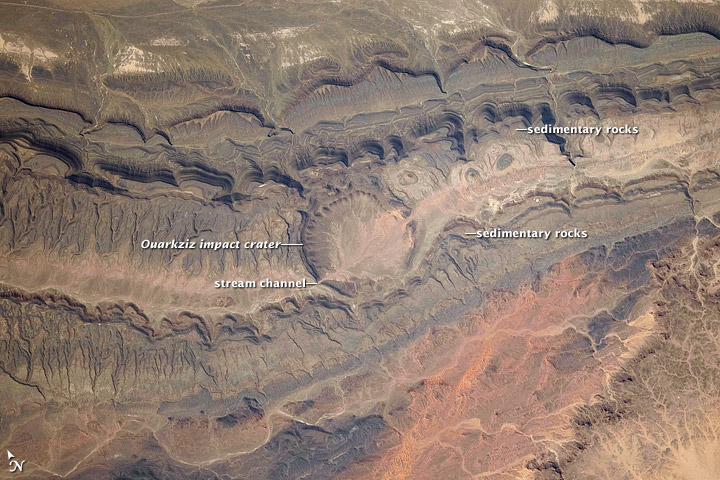New Astronaut Photo Highlights Impact Crater


Astronauts aboard the International Space Station have snapped a stunning new photo of a heavily eroded impact crater in Algeria.
The image shows Ouarkziz Crater, a 2.2-mile-wide (3.5-kilometer) hole in the ground in northwestern Algeria, near the border with Morocco. It was formed by an asteroid impact less than 70 million years ago, during the late Cretaceous Period of the Mesozoic Era, which is also known as the "Age of Dinosaurs."
A much larger impact a few million years later famously brought this age to an end. A space rock measuring roughly 6 miles (10 km) across slammed into Earth just off Mexico's Yucatan Peninsula 65 million years ago, driving the dinosaurs to extinction and clearing a path for the rise of the mammals.
For comparison, the dinosaur-killing asteroid left a crater about 110 miles (180 km) wide.
Originally called Tindouf, the circular Ouarkziz has been greatly eroded since its formation so many years ago. While the feature may be tough to pick up from the ground, it's clearly visible to camera-wielding astronauts aboard the station, which zips around our planet at an altitude of 240 miles (386 km).
The crater is younger than the sedimentary rocks that surround it, researchers said. But a stream channel cutting across the center of the crater formed after the impact.
The photo was taken April 21 by crewmembers of the orbiting lab's now-completed Expedition 30. NASA astronaut Dan Burbank served as commander of the expedition; he was joined by fellow American Don Pettit, Dutch spaceflyer Andre Kuipers and Russian cosmonauts Anton Shkaplerov, Anatoly Ivanishin and Oleg Kononenko.
Get the world’s most fascinating discoveries delivered straight to your inbox.
Burbank, Shkaplerov and Ivanishin returned to Earth on April 27. The other three will have the space station to themselves until May 17, when the rest of the new Expedition 31 crew — NASA astronaut Joe Acaba and cosmonauts Gennady Padalka and Sergei Revin — are slated to arrive.
The photo was taken with a Nikon D3X digital camera using a 400 mm lens.It has been cropped and enhanced to improve contrast, and lens artifacts have been removed, NASA officials said.
Follow OurAmazingPlanet for the latest in Earth science and exploration news on Twitter @OAPlanet and on Facebook.



